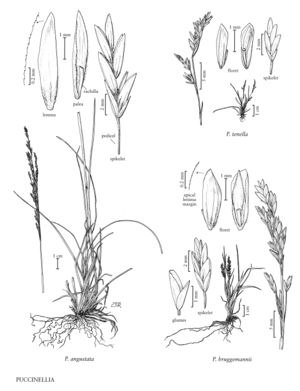Puccinellia tenella
Plants perennial; cespitose, not mat-forming. Culms 3-16 cm, erect. Ligules 0.5-1.7 mm, acute, obtuse, or truncate, entire; blades usually involute and 0.4-0.7 mm in diameter, occasionally flat and 0.5-1.5 mm wide. Panicles 1.6-5.5 cm, usually contracted, sometimes diffuse, lower branches erect or ascending, spikelets usually confined to the distal 1/2; pedicels smooth, with tumid epidermal-cells. Spikelets 3.5-7 mm, with 3-6 florets. Glumes slightly keeled over the back, veins distinct, apices acuminate to acute; lower glumes 0.7-1.3 mm; upper glumes 1.3-1.8 mm; calluses glabrous or with 5 or fewer hairs shorter than 0.1 mm; lemmas 2-2.5 mm, herbaceous, usually purple with whitish margins, smooth, glabrous or with a few hairs on the bases of the lateral-veins, backs rounded, 5-veined, veins distinct, not extending to the margins, apical margins smooth, apices obtuse to truncate, entire or slightly erose; palea veins smooth, glabrous; anthers 0.6-0.9 mm. 2n = 14.
Distribution
Maine, Mass., N.Y., Alaska, N.H., R.I., Vt., Conn., Greenland, Man., N.B., Nfld. and Labr., N.S., N.W.T., Nunavut, Ont., P.E.I., Que.
Discussion
Puccinellia tenella is a halophytic, circumpolar subarctic and low arctic species. It is found above the high tide zone on sandy spits, in salt marshes, in silty soils, and among granitic rocks to 30 m above sea level. The above description applies to P. tenella subsp. langeana (Berlin) Tzevlev, the only subspecies in the Flora region. Puccinellia alaskana Scribn. &; Merr., considered a subspecies of P. langeana (Berlin) T.J. Sørensen ex Hulten [= P. tenella] by Sørensen (1953), has acute lemmas and hairs on the palea. It is discussed under P. pumila (see p. 471).
Selected References
None.
Lower Taxa
"wide" is not a number."decumbent" is not a number.
